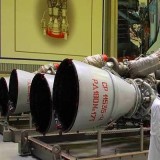US Intelligence Report: China’s H-20 Stealth Bomber to Transform Strategic Power Projection by the 2030s

{loadposition bannertop}
{loadposition sidebarpub}
The United States Department of Defense intelligence services have shed light on China’s ambitious development of the H-20 stealth strategic bomber, a platform poised to redefine the People’s Liberation Army Air Force (PLAAF) and its long-range strike capabilities. Expected to become operational by the 2030s, the H-20 represents a significant leap in China’s military modernization efforts. Although claims from Beijing suggest the bomber’s unveiling is imminent, analysts project a more measured timeline, reflecting the technical complexities involved in developing such advanced systems.Follow Army Recognition on Google News at this link
Graphic Illustration of the Future H-20 Stealth Bomber: A conceptual rendering of China’s H-20 strategic bomber’s advanced flying-wing design. (Picture source: Social Network)
The H-20 is designed as a cutting-edge platform intended to rival the most sophisticated bombers in the world, particularly those of the United States. With an impressive range exceeding 10,000 km (6,214 miles), it will possess the ability to strike intercontinental targets, a capability further enhanced by potential aerial refueling. The bomber is expected to carry both nuclear and conventional munitions, including land-attack and anti-ship missiles, making it versatile for a range of strategic and tactical missions. Its flying-wing design, reminiscent of the U.S. B-2 Spirit, emphasizes stealth, with a reduced radar cross-section aimed at evading advanced air defense systems.
Strategically, the H-20 is set to extend China’s reach far beyond the “Second Island Chain,” encompassing critical U.S. territories such as Guam, Hawaii, and even parts of the continental United States. The bomber’s development signals a shift in China’s military doctrine, transitioning from regional to global power projection. Replacing the aging H-6 bomber family, the H-20 is expected to become the PLAAF’s premier long-range strike platform. The dual-role capability of carrying both nuclear and conventional payloads enhances its strategic value, serving as both a deterrent and an offensive asset.
Comparisons to American counterparts, particularly the U.S. B-2 Spirit, reveal both similarities and differences. The B-2, introduced in the late 1980s, set a benchmark for stealth technology with its flying-wing design, low radar cross-section, and advanced avionics. The H-20 mirrors this concept but benefits from decades of technological advancement since the B-2’s inception. However, the U.S. maintains a lead in stealth and long-range strike technology, as evidenced by the development of the Northrop Grumman B-21 Raider. Slated to replace the B-2, the B-21 features enhanced stealth, networking, and battlefield integration capabilities, including interoperability with unmanned systems. By the time the H-20 becomes operational, it will likely face stiff competition from a mature fleet of B-21s and other advanced U.S. platforms.
The H-20 is not only a reflection of China’s ambition but also part of the broader transformation of its defense aerospace industry. Over the past two decades, China has shifted from a technology importer to a leader in military aviation, rivaling the United States, Russia, and European powers. The state-owned Aviation Industry Corporation of China (AVIC) has spearheaded efforts to develop advanced platforms, including the J-20 stealth fighter, Y-20 heavy transport aircraft, and an array of unmanned aerial vehicles (UAVs). The J-20, for instance, is China’s first fifth-generation fighter and represents a leap in air combat capability, competing with the U.S. F-22 and F-35 in areas such as stealth, avionics, and supercruise capabilities. Although it may not yet match its American counterparts in all respects, the J-20’s deployment in significant numbers underscores China’s ability to produce and field advanced systems at scale.
China’s Y-20 heavy transport aircraft adds strategic airlift capabilities comparable to the U.S. C-17 Globemaster III, supporting logistical operations and humanitarian missions. In the UAV domain, China has achieved global recognition with the Wing Loong and CH series drones, which are not only deployed domestically but also widely exported and used in conflicts worldwide. The ability to produce advanced UAVs at a lower cost than Western counterparts has bolstered China’s position in the global defense market.
The H-20 stealth bomber is reported to feature a design similar to the U.S. B-21 Raider, with a sleek flying-wing architecture optimized for stealth and long-range missions. (Picture source U.S. DoD)
Compared to the United States, which leads in stealth, systems integration, and overall technological sophistication, China’s defense aerospace strategy emphasizes rapid iteration and large-scale production. While individual Chinese systems may lag in certain areas, the sheer volume of platforms being developed and fielded allows China to quickly build capability and readiness. The H-20, for instance, may not immediately rival the U.S. B-21 Raider in operational flexibility or stealth, but its eventual production in large numbers could provide China with a strategic advantage in capacity.
Globally, China’s defense aerospace advancements have outpaced traditional powers such as Russia, which has faced budgetary constraints and limited production capacity. While Russia continues to develop platforms like the Su-57 stealth fighter, its influence has waned compared to China’s ability to innovate and field competitive systems at scale. Furthermore, China benefits from a rapidly advancing domestic technology sector, which provides critical innovations in artificial intelligence, materials science, and electronic warfare systems.
The H-20’s development, alongside other advancements, symbolizes China’s determination to reshape the global balance of airpower. Its ability to transition from regional dominance to global reach represents a strategic shift that has implications for international security. Although significant technological hurdles remain—particularly in stealth materials, sensor integration, and reliability—China’s trajectory suggests it will continue to challenge established aerospace powers like the U.S. and Europe.
Ultimately, the H-20 and the broader modernization of China’s defense aerospace industry reflect an ambition to achieve parity—and eventually supremacy—in the skies. These advancements are not just technological achievements but also key components of China’s strategy to assert influence and deter adversaries on a global stage. As the H-20 program progresses, it will remain a focal point of military analysis and a symbol of China’s growing aerospace capabilities.

{loadposition bannertop}
{loadposition sidebarpub}
The United States Department of Defense intelligence services have shed light on China’s ambitious development of the H-20 stealth strategic bomber, a platform poised to redefine the People’s Liberation Army Air Force (PLAAF) and its long-range strike capabilities. Expected to become operational by the 2030s, the H-20 represents a significant leap in China’s military modernization efforts. Although claims from Beijing suggest the bomber’s unveiling is imminent, analysts project a more measured timeline, reflecting the technical complexities involved in developing such advanced systems.
Follow Army Recognition on Google News at this link
Graphic Illustration of the Future H-20 Stealth Bomber: A conceptual rendering of China’s H-20 strategic bomber’s advanced flying-wing design. (Picture source: Social Network)
The H-20 is designed as a cutting-edge platform intended to rival the most sophisticated bombers in the world, particularly those of the United States. With an impressive range exceeding 10,000 km (6,214 miles), it will possess the ability to strike intercontinental targets, a capability further enhanced by potential aerial refueling. The bomber is expected to carry both nuclear and conventional munitions, including land-attack and anti-ship missiles, making it versatile for a range of strategic and tactical missions. Its flying-wing design, reminiscent of the U.S. B-2 Spirit, emphasizes stealth, with a reduced radar cross-section aimed at evading advanced air defense systems.
Strategically, the H-20 is set to extend China’s reach far beyond the “Second Island Chain,” encompassing critical U.S. territories such as Guam, Hawaii, and even parts of the continental United States. The bomber’s development signals a shift in China’s military doctrine, transitioning from regional to global power projection. Replacing the aging H-6 bomber family, the H-20 is expected to become the PLAAF’s premier long-range strike platform. The dual-role capability of carrying both nuclear and conventional payloads enhances its strategic value, serving as both a deterrent and an offensive asset.
Comparisons to American counterparts, particularly the U.S. B-2 Spirit, reveal both similarities and differences. The B-2, introduced in the late 1980s, set a benchmark for stealth technology with its flying-wing design, low radar cross-section, and advanced avionics. The H-20 mirrors this concept but benefits from decades of technological advancement since the B-2’s inception. However, the U.S. maintains a lead in stealth and long-range strike technology, as evidenced by the development of the Northrop Grumman B-21 Raider. Slated to replace the B-2, the B-21 features enhanced stealth, networking, and battlefield integration capabilities, including interoperability with unmanned systems. By the time the H-20 becomes operational, it will likely face stiff competition from a mature fleet of B-21s and other advanced U.S. platforms.
The H-20 is not only a reflection of China’s ambition but also part of the broader transformation of its defense aerospace industry. Over the past two decades, China has shifted from a technology importer to a leader in military aviation, rivaling the United States, Russia, and European powers. The state-owned Aviation Industry Corporation of China (AVIC) has spearheaded efforts to develop advanced platforms, including the J-20 stealth fighter, Y-20 heavy transport aircraft, and an array of unmanned aerial vehicles (UAVs). The J-20, for instance, is China’s first fifth-generation fighter and represents a leap in air combat capability, competing with the U.S. F-22 and F-35 in areas such as stealth, avionics, and supercruise capabilities. Although it may not yet match its American counterparts in all respects, the J-20’s deployment in significant numbers underscores China’s ability to produce and field advanced systems at scale.
China’s Y-20 heavy transport aircraft adds strategic airlift capabilities comparable to the U.S. C-17 Globemaster III, supporting logistical operations and humanitarian missions. In the UAV domain, China has achieved global recognition with the Wing Loong and CH series drones, which are not only deployed domestically but also widely exported and used in conflicts worldwide. The ability to produce advanced UAVs at a lower cost than Western counterparts has bolstered China’s position in the global defense market.

The H-20 stealth bomber is reported to feature a design similar to the U.S. B-21 Raider, with a sleek flying-wing architecture optimized for stealth and long-range missions. (Picture source U.S. DoD)
Compared to the United States, which leads in stealth, systems integration, and overall technological sophistication, China’s defense aerospace strategy emphasizes rapid iteration and large-scale production. While individual Chinese systems may lag in certain areas, the sheer volume of platforms being developed and fielded allows China to quickly build capability and readiness. The H-20, for instance, may not immediately rival the U.S. B-21 Raider in operational flexibility or stealth, but its eventual production in large numbers could provide China with a strategic advantage in capacity.
Globally, China’s defense aerospace advancements have outpaced traditional powers such as Russia, which has faced budgetary constraints and limited production capacity. While Russia continues to develop platforms like the Su-57 stealth fighter, its influence has waned compared to China’s ability to innovate and field competitive systems at scale. Furthermore, China benefits from a rapidly advancing domestic technology sector, which provides critical innovations in artificial intelligence, materials science, and electronic warfare systems.
The H-20’s development, alongside other advancements, symbolizes China’s determination to reshape the global balance of airpower. Its ability to transition from regional dominance to global reach represents a strategic shift that has implications for international security. Although significant technological hurdles remain—particularly in stealth materials, sensor integration, and reliability—China’s trajectory suggests it will continue to challenge established aerospace powers like the U.S. and Europe.
Ultimately, the H-20 and the broader modernization of China’s defense aerospace industry reflect an ambition to achieve parity—and eventually supremacy—in the skies. These advancements are not just technological achievements but also key components of China’s strategy to assert influence and deter adversaries on a global stage. As the H-20 program progresses, it will remain a focal point of military analysis and a symbol of China’s growing aerospace capabilities.




